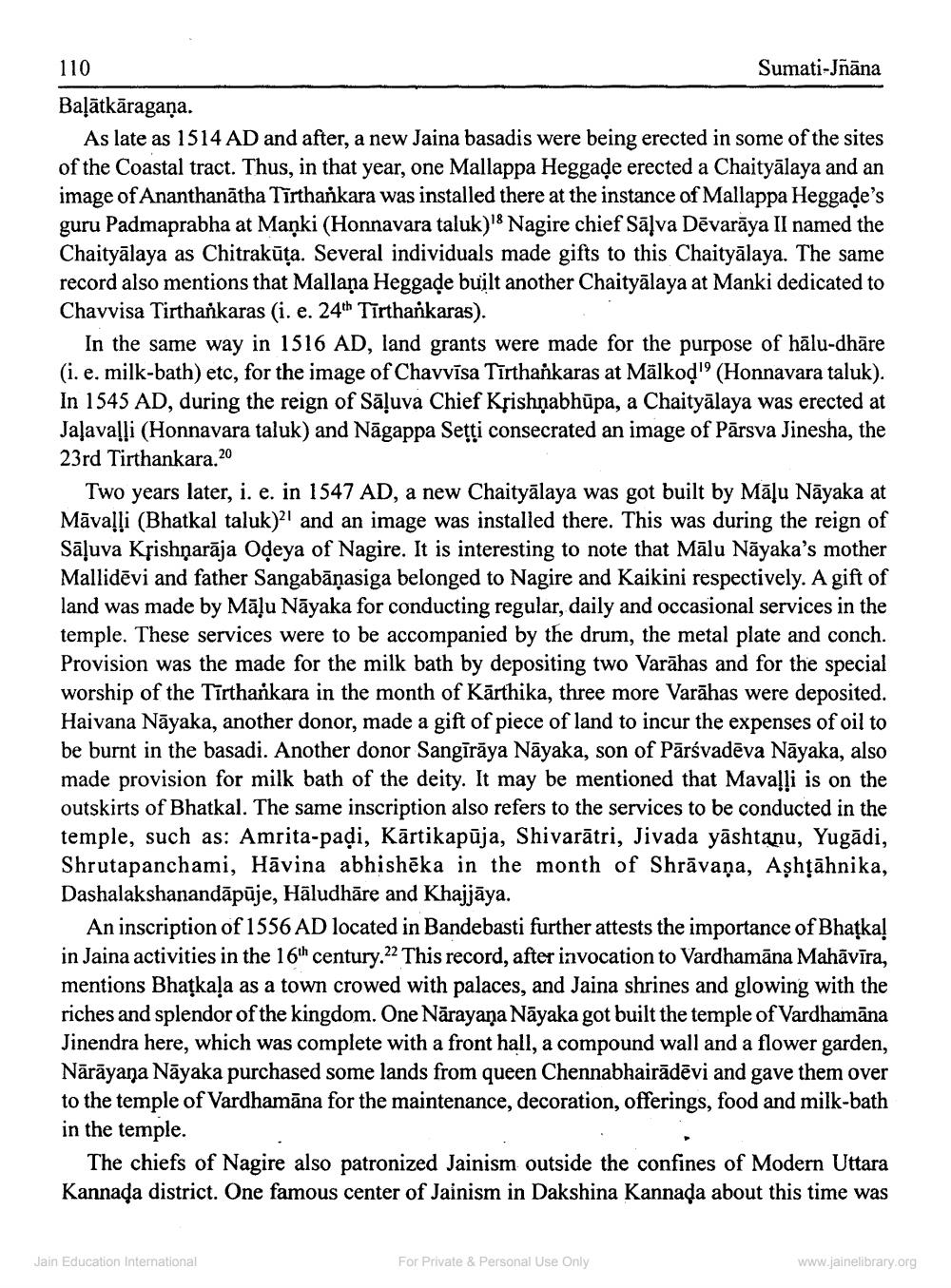________________
110
Sumati-Jñāna Baļātkāragana.
As late as 1514 AD and after, a new Jaina basadis were being erected in some of the sites of the Coastal tract. Thus, in that year, one Mallappa Heggade erected a Chaityālaya and an image of Ananthanātha Tīrthankara was installed there at the instance of Mallappa Heggade's guru Padmaprabha at Manki (Honnavara taluk)' Nagire chief Sāļva Dēvarāya II named the Chaityālaya as Chitrakūta. Several individuals made gifts to this Chaityālaya. The same record also mentions that Mallana Heggade built another Chaityālaya at Manki dedicated to Chavvisa Tirthařkaras (i. e. 24th Tīrthankaras).
In the same way in 1516 AD, land grants were made for the purpose of hālu-dhāre (i. e. milk-bath) etc, for the image of Chavvīsa Tīrthankaras at Mālkod!' (Honnavara taluk). In 1545 AD, during the reign of Sāļuva Chief Krishnabhūpa, a Chaityālaya was erected at Jalavalli (Honnavara taluk) and Nāgappa Setti consecrated an image of Pārsva Jinesha, the 23rd Tirthankara.20
Two years later, i. e. in 1547 AD, a new Chaityālaya was got built by Māļu Nāyaka at Māvalli (Bhatkal taluk)2 and an image was installed there. This was during the reign of Sāļuva Krishnarāja Odeya of Nagire. It is interesting to note that Mālu Nāyaka's mother Mallidēvi and father Sangabāṇasiga belonged to Nagire and Kaikini respectively. A gift of land was made by Māļu Nāyaka for conducting regular, daily and occasional services in the temple. These services were to be accompanied by the drum, the metal plate and conch Provision was the made for the milk bath by depositing two Varāhas and for the special worship of the Tīrthařkara in the month of Kārthika, three more Varāhas were deposited. Haivana Nāyaka, another donor, made a gift of piece of land to incur the expenses of oil to be burnt in the basadi. Another donor Sangīrāya Nāyaka, son of Pārsvadēva Nāyaka, also made provision for milk bath of the deity. It may be mentioned that Mavalli is on the outskirts of Bhatkal. The same inscription also refers to the services to be conducted in the temple, such as: Amrita-padi, Kārtikapūja, Shivarātri, Jivada yāshtanu, Yugādi, Shrutapanchami, Hāvina abhishēka in the month of Shrāvana, Ashtāhnika, Dashalakshanandāpūje, Hāludhāre and Khajjāya.
An inscription of 1556 AD located in Bandebasti further attests the importance of Bhatka! in Jaina activities in the 16th century.22 This record, after invocation to Vardhamāna Mahāvīra, mentions Bhatkaļa as a town crowed with palaces, and Jaina shrines and glowing with the riches and splendor of the kingdom. One Nārayana Nāyaka got built the temple of Vardhamāna Jinendra here, which was complete with a front hall, a compound wall and a flower garden, Nārāyana Nāyaka purchased some lands from queen Chennabhairādēvi and gave them over to the temple of Vardhamāna for the maintenance, decoration, offerings, food and milk-bath in the temple.
The chiefs of Nagire also patronized Jainism outside the confines of Modern Uttara Kannada district. One famous center of Jainism in Dakshina Kannada about this time was
Jain Education International
For Private & Personal Use Only
www.jainelibrary.org




